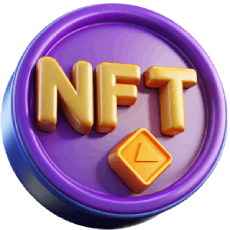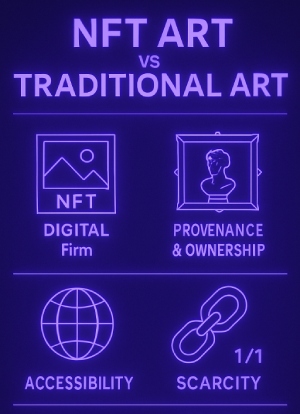What is NFT Art?
At its core, NFT art is really just digital art that is associated with a Non-Fungible Token or Token (NFT), which is a unique blockchain token representing ownership of a particular digital asset. While ordinarily, digital files can be easily copied or shared, in the case of an NFT, you own literally the original and verified copy of that artwork. This, in fact, is a revolutionary way to approach art in the digital age.
Using blockchain technology, an NFTs create an immutable record of ownership so that an artwork must always trace back to its original creator. The value of an NFT art lies in its unique quality of being desired, genuine, and irreproducible-the very opposite of another digital file.
How Does NFT Art Work?
One would use blockchain technology to ensure that ownership and authenticity are applied to a digital artwork: this is the mechanism that governs an NFT art. Here's the typical course of the process:

Creating and Minting NFT Art
This is the very first step of punting a piece of digital artwork as an NFT. It requires that once the file (JPEG, GIF, a video, or music) is uploaded to a platform supported by blockchain, it becomes a one-of-a-kind token on the blockchain, which then can be bought, sold, or traded on NFT marketplaces such as OpenSea or Rarible.
Buying and Selling of NFTs
Once an artwork is minted as an NFT, it goes up for sale by means of cryptocurrency usually something like Ether. When a collector purchases the NFT, the ownership of the token, which implies that ownership of the digital artwork, goes to this collector. This transaction is then registered securely on the blockchain, hence giving a permanent record of the sale.
Royalties and Smart Contracts
A tremendous advantage for the artist in terms of NFT art is that inside the artwork may be carved a royalty situation through a smart contract. This way, artists earn a percentage of each resale that occurs on the secondary market, giving artists on-the-go passive income whenever their artwork is handed from one owner to another.
NFT Art vs. Traditional Art
Both NFT art and classical art seek to register creativity and stir up emotion. But their means of operations and their valuation differ from a series of perspectives.

Digital vs. Physical
Traditionally, galleries sell physical art; that is paintings, sculptures, photographs-if it is NFT art, it is purely digital. Anybody might view or download a digital file, but with an NFT, there is a single authenticated original version, just like owning an original painting in the physical world.
Provenance and Ownership
The procedure of establishing ownership and proving authenticity in traditional art requires certificates, appraisals, or experts' views. Conversely, NFT art uses blockchain technology to bring about a clear and transparent ownership record. Each transaction and transfer of ownership is duly recorded to make an artist's provenance easily traceable.
Accessibility and Worldwide Reach
With the emergence of NFT platforms, an opportunity has been created for artists to share their work with global audiences. Instead of depending on galleries and auction houses, artists have the power to mint and sell their works directly to collectors far and wide. The global outreach of the internet truly democratizes NFT art.
Scarcity and Value
Whereas scarcity has been the key to value for traditional art since time immemorial, digital art can be scarce through NFTs. Artists can create limited editions or even a single unique token for each artwork, ensuring digital scarcity. How this feeling of rarity combined with verifiable ownership establishes a value for NFT art is pretty much the same as how limited-run prints or one-of-a-kind paintings are valued in the traditional art market.
Why Does NFT Art Matter
NFT art is more than just an ephemeral trend-it brings about a paradigm shift in how creativity, ownership, and value are all considered in the digital age. Here are some reasons that make it such a groundbreaking development:
- Empowering Artists: One benefit the NFT art brings is the ability for artists to interact directly with their audience, sell their works without the involvement of any intermediaries, and receive royalties from secondary sales.
- Transparency and Trust: From verifiable ownership to higher transparency, blockchain operates without requiring expensive authentication, thereby reducing possible avenues for fraud.
- Another Aspect of Investing: An NFT can be bought and held as an asset whose value may appreciate over time, much like a piece of art or real estate.
- Accessibility across Countries: The NFT platforms allow artists and buyers from anywhere across the globe to connect, thus removing geographical and economic barriers.
The Future of NFT Art
The NFT art market is fairly recent; however, that makes for limitless potential. It involves creating, marketing, and collecting art in terms very different from any that have ever existed. Because technology is constantly evolving and new artists and collectors are continually entering the scene, it is conceivable that NFT art can become a major segment of the broader digital economy.
If you are an artist looking to showcase your work in a new way or a collector wanting to invest in digital art, some infinite opportunities await you in the NFT space. This idea of owning a piece of art both unique and digitally verified is slowly starting to reshape the creative landscape.
Quick Links
🙄What is #NFT?
— VIW (@VIW_World) February 27, 2023
💡Non-fungible tokens are unique and similar to non-identical citizenship cards. NFTs are guaranteed unique by permanently leaving transaction details on the #blockchain.
🔗Detailhttps://t.co/KFx3AY90fN pic.twitter.com/FKHSKYQgga